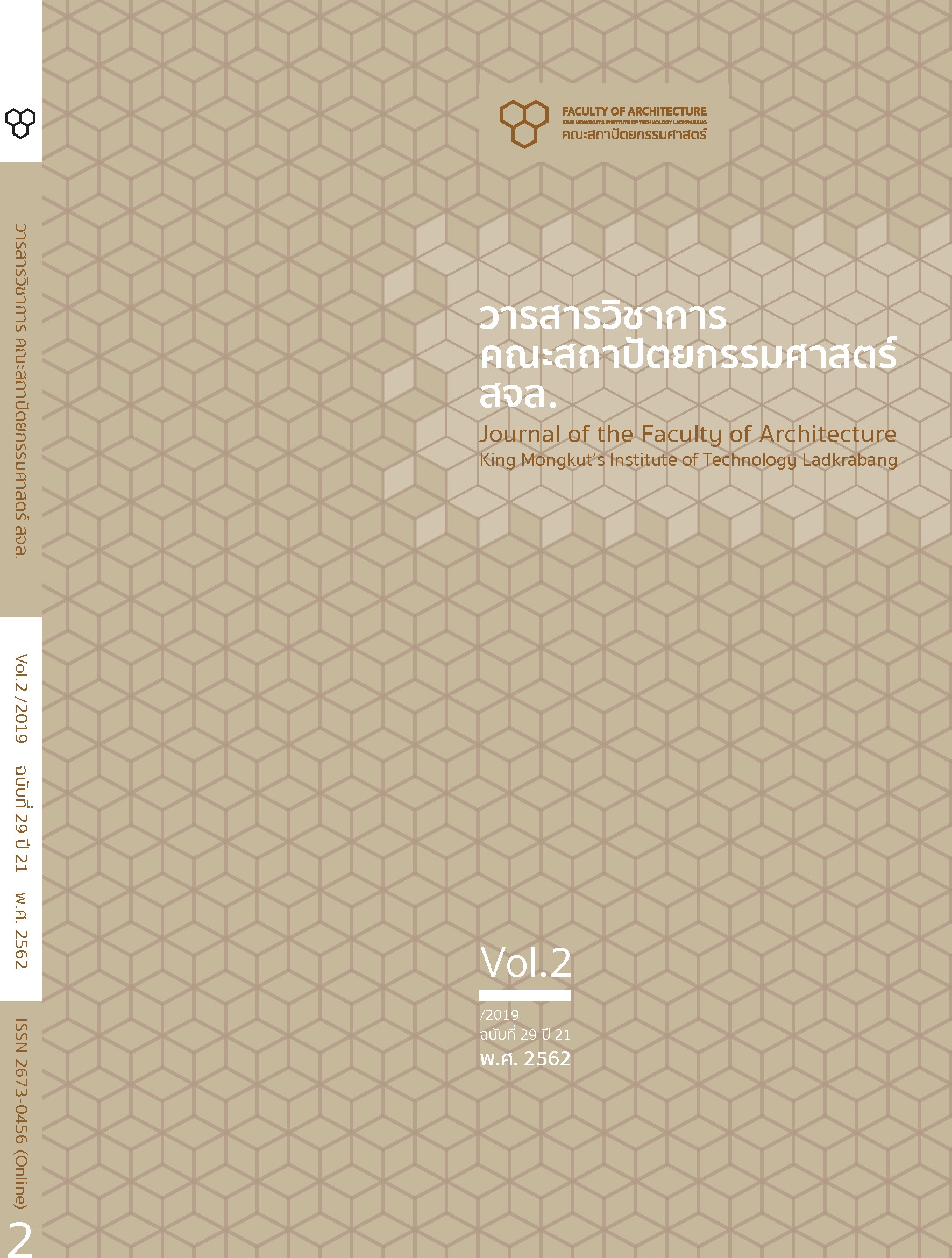Natural Environment and Comfort Condition in Semi-Open Atrium: Case Studies of Semi-Open Shopping Malls in Bangkok
Main Article Content
Abstract
"Semi-open shopping malls" are a sustainable architecture type having an attractive contemporary concept of "Green lifestyle Mall." An atrium inside the mall is a non-air-conditioning public space enclosed by retail shops. The atrium is covered by a wide-span roof to protect rain and heat but provides natural sunlight. The large openings of the mall are opened for natural ventilation. The atrium also contains attractive gardens and public recreation areas. This research aims to study the performances of the building type by evaluating the natural qualities and the comfort conditions of the atrium environment.
The main 4 research frameworks are heat, ventilation, sunlight and green areas. The samples are 8 case studies from a population of 50 projects. The methodology starts with measuring the temperature, humidity, wind speed, and illumination on site in summer. Next, the data are analyzed and transformed into the natural environmental indexes. Then, the environmental qualities are evaluated and comparatively reported with pros and cons. Lastly, the thermal conditions of each case studies are plotted into charts by a thermal comfort tool, complied with ASHRAE Standard 55-2017.
Summary of the findings reveals that 3 out of 8 case studies are in acceptable thermal comfort zones. Results of the average environmental index are as follows; The difference in temperature inside-outside is 1.15 °C. The mean radiation temperature is 32.45 °C. The operative temperature is 32.54 °C. The efficiency of air velocity is 0.41 %. The daylight factor is 0.20 %. And the proportion of the green area is 0.14 %. The strengths and weaknesses of the case study performances are discussed to provide the building design recommendations
Article Details
This work is licensed under a Creative Commons Attribution-NonCommercial-ShareAlike 4.0 International License.
Copyright Transfer Statement
The copyright of this article is transferred to Journal of The Faculty of Architecture King Mongkut's Institute of Technology Ladkrabang with effect if and when the article is accepted for publication. The copyright transfer covers the exclusive right to reproduce and distribute the article, including reprints, translations, photographic reproductions, electronic form (offline, online) or any other reproductions of similar nature.
The author warrants that this contribution is original and that he/she has full power to make this grant. The author signs for and accepts responsibility for releasing this material on behalf of any and all co-authors.
References
เกษธวัช พ่วงเพิ่ม. (2553). ลานพื้นที่ว่างส่วนกลางของศูนย์การค้าระดับชุมชน และความเป็นพื้นที่กึ่งสาธารณะ ของชุมชนเมืองกรุงเทพมหานคร. (วิทยานิพนธ์การวางแผนชุมชนเมืองและสภาวพแวดล้อมมหาบัณฑิต, มหาวิทยาลัยศิลปากร).
ญาณ เกห์ล. (2559). เมืองของผู้คน. (ศรีสุเมธ ฤทธิไพโรจน์, แปล.). กรุงเทพฯ: ลายเส้น พับบลิชชิ่ง.
ปรเมศร์ อมาตยกุล. (2549). การประมาณค่าดรรชนีความร้อนโดยวิธี Steadman. เข้าถึงได้จาก: http://www.arcims.tmd.go.th/Research_files/Estimating%20Heat%20Index%20Value%20Using%20Stead mans%20Method.pdf.
ศศิธร ศรีเฟื่องฟุ้ง. (2560). การศึกษาความสบายเชิงอุณหภาพของคนไทยภายในสถาปัตยกรรมประเภทโบสถ์. วารสารวิชาการมหาวิทยาลัยอีสเทิร์นเอเชีย ฉบับวิทยาศาสตร์และเทคโนโลยี. 11(3), 85-98.
สุดาภรณ์ สุดประเสริฐ. (2559). การสำรวจสภาวะสบายเชิงความร้อนของนักศึกษาในห้องไม่ปรับอากาศ. วารสารวิชาการ คณะสถาปัตยกรรมศาสตร์ มหาวิทยาลัยขอนแก่น. 15(2), 147-160.
ASHRAE. (2017 a). ANSI/ASHRAE Standard 55-2017: Thermal Environmental Conditions for Human Occupancy. Atlanta: ASHRAE. ASHRAE. (2017 b). 2017 ASHRAE Handbook Fundamentals (SI Edition). Atlanta: ASHRAE.
Atthakorn, S. (2019). Airflow Patterns of Semi-Open Shopping Malls in Bangkok. In K. Wongwailkhit (Eds.). Proceedings of the 4th RSU International Research Conference 2019. (pp. 527-542). Pathumthani: Research Institute, Rangsit University.
Givoni, B. (1998). Climate Considerations in Building and Urban Design. New York: John Wiley and Sons.
Khedari, J., Yamtraipat, N., Pratintong, N., & Hirunlabh, J. (2000). Thailand Ventilation Comfort Chart. Energy and Buildings. 2000(32), 245-249.
Lechner, N. (2015). Heating, Cooling, Lighting; Sustainable Design Methods for Architects. 4th ed. New Jersey: John Wiley & Sons.
Olgyay, V. (1963). Design with Climate. Princeton: Princeton University Press. Perry, L. (2018). The Green Mountain Gardener Articles: Benefits of Using Plants Indoors. Retrieved from: http://pss.uvm.edu/ppp/articles/healthyin.html.
Grondzik, W., Kwok, A., Stein, B., and Reynolds, J. (2014). Mechanical and Electrical Equipment for Building. 12th ed. New Jersey: John Wiley & Sons. Tyler, H., Stefano, S., Alberto, P., Toby, C., Dustin, M., and Kyle, S. (2017). CBE Thermal Comfort Tool. Retrieved from: http://comfort.cbe.berkeley.edu/.


